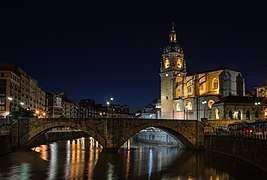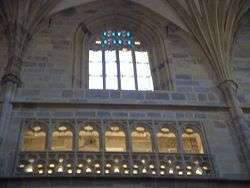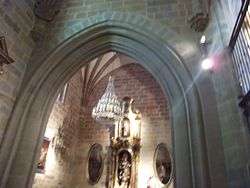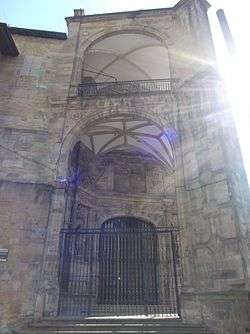Church of Saint Anthony the Great
The Church of San Antón is a Catholic temple located in the Old Town neighbourhood of Bilbao, Spain. It is dedicated to Anthony the Great, known as San Antón in Spanish. It is featured, along with the San Antón Bridge, in the city's coat of arms. The estuary of Bilbao flows next to it.
| Church of San Antón San Anton eliza | |
|---|---|
 | |
| Religion | |
| Affiliation | Roman Catholic |
| Province | Biscay |
| Location | |
| Location | Bilbao, Basque Country, Spain |
| Architecture | |
| Type | Church |
| Style | Gothic, Renaissance, Baroque |
| Groundbreaking | 15th century |
| Completed | 1510 |
Introduction
The Gothic style is an artistic style of the 15th and 16th centuries. The great majority of those centuries' buildings have deteriorated with the passing of time and have been reconstructed. Consequently, they do not support the same Gothic essence anymore. Nevertheless, in buildings such as Saint Anthony's church, even though it has been reconstructed, it is possible to observe some Gothic features as the rib vaults and the pointed arches.
History
The church was built at the end of the 15th century on a plot where there had been a years a warehouse for three hundred years. It is considered an asset of cultural interest since 17 July 1984, in the category "National Historic-Artistic Monument".

In 1300 Diego López de Haro gave the municipal charter. The river and the plot were incorporated to the new village called Bilbao. Some claim that in 1334 Alfonso XI of Castile ordered to build a fortress and wall that were used like a dike against the flood. A wall was discovered in 2002 by an archaeological excavation but the claim is still inconclusive.
Some time later this two buildings were replaced by one church dedicated to Saint Anton Abbot. This church was consecrated in 1433. In that moment the church only has one nave with a rectangular floor and a vaulted roof. Nowadays we can see the old foundations of that church near the old wall of Bilbao.

In 1478 they start a new project to increase the church, because it was very small and the congregation of faithful people was increasing. This enlargement, in Gothic style, was finished in the first part of the 16th century.
Throughout history this church has suffered a lot of damages and was closed two times. The main source of damage was the Nervión river because the church is very close to it. A lot of flooding happened during the history and a part of the furniture inside was affected by it. The last flood was in 1983 and it affected the church; it destroyed furniture, drag doors and railings.
During the war the bombing and fire the church suffer a lot of damages. Especially during the Carlist war. Caused by this war the church had to close because it was used like warehouse of management. The second time when Saint Anton had to close was in 1881. This was caused by the tumbledown state of the church. This restoration done by Sabino Goikoetxea was very polemic because he change a lot of original things.
Gothic art in Biscay
Gothic art was created in France in the 13th century, but it is not until the 14th century when it was introduced in Biscay, due to the poverty. In the 14th century the population and the economy grew, carrying the Gothic into Biscay.

The ogival art or Gothic art was born in France, and it was extended to the rest of Europe. In Spain the ogival architecture is used a half century later than in France. As the French influence entered by Navarre, it avoided the Basque Country, so it was even later when it came to Biscay. Most of the buildings are not really big, even if we can find Santiago's cathedral in Bilbao or Andra Mari of Lekeitio.
The Gothic architecture, with its ogival arches (that is why it is also called ogival architecture), was what they needed in Biscay. This arches needed an exterior backing, which began in the wall. The concentric arches became peaked and ogival, instead of the half-pointed arches. They were adorned with vegetal, zoomorphic or human representations. The vaults began being as simple-ribbed but finally they were used terceletes.
Most of the buildings were begun in the 14th century, but only Santiago's cathedral was ended then. The rest were consecrated between the 15th and 16th centuries.
The Biscay Gothic lost the spirit of the International Gothic: they were not monumental buildings with windows which played with the light creating a mystical aura inside, but small buildings, becoming that a characteristic of the local Gothic.
Andra Mari of Guernica, Getxo, Orduña, Gueñes, Erandio, Galdakao, Portugalete and Lekeitio, Santa Eufemia of Bermeo, Santiago's Cathedral, Basilica of Begoña, San Vicente and San Anton of Bilbao and San Severino of Balmaseda have to be named as important buildings of the Gothic of Biscay.
Chapels of San Antón
The Church of San Antón contains three chapels:
Chapel of Provost
It is the first and widest chapels that the Church of San Antón possesses. Built in 1530 this chapel is an example of the late Gothic style which can be seen in other nearby construction like Begoña, La encarnación, San Vicente of Abando and San Pedro of Deusto. There is a big ogival arch at the entrance of the chapel. This arch is closed by a grille that was forged in Bilbao. At the top of the entrance it is located this chapels founder's coat of arms: the Lezama-Leguizamón family's coat of arms. In the past there was a passageway that linked this chapel and Lezama-Leguizamón family's tower house. There is a stained glass window located in the front wall.
.jpg)
The chapel held two altarpieces. One of the altarpieces is dedicated to Santa Ana and the other is dedicated to Virgen de la Consolación. At present the chapel contains an altar that contains a wood carved sculpture of Inmaculada and some paintings.
There is also a silver lamp with the following inscription carved on it: "Esta lámpara dieron a su capilla de Santa Ana, Doña María de Leguizamón y Don Domingo de Isasi-Leguizamón. 1621"

Chapel of Piety
The Chapel of Piety is smaller than the Chapel of Provost but bigger than the Chapel of San Roque. It possesses similar attributes of those present in the Chapel of Provost. It has a Gothic structure in the entrance arch, rib vault on the ceilings and stained glass windows.
The grille closing this chapel is older than the grille closing the Chapel of Provost. The top part of this grille includes the coat of arms of the Recalde family along with details of The Passion.
The intermediate frieze contains the following inscription written in Latin: "O Mater Dei, memento mei Iesu". It could be translated as "Oh mother of god, remember us before Jesus".
In 1919 the Chapel of Provost and the Chapel of Piety were united with a Gothic arch to enlarge the communion rail.
Chapel of San Roque
It's the smallest chapel out of the three that the church of San Anton possess. This chapel is composed by a rib vault and a small blinded Gothic window in the right wall. It was the first entrance of the church.
When the new main front was built the Ibiceta family which had their family sepulchre in the chapel decided to transform it to an artistic mausoleum with prayerful sculptures and diverse decorative elements. The chapel contains a round-headed arch sustained by Corinthians columns.
At present days there are present in this chapel the sculpture of San Roque above the sepulture and the sculptures of Santa Lucia and San Sebastian flanking it.
Façade of Renaissance

The Saint Anthon church, in Bilbao, contains a typical front, not of the own and general style of the church, which is the Gothic, but of the Renaissance style born in the 16th century. This owes to the repeated reforms to which the church has been submitted, and every reform has contributed something new and characteristic of that epoch.
To begin with, it is necessary to emphasize that there exist features that belong neither to the Renaissance nor to the Gothic. Example of it we have the arches of the entry. These arches are called round arches and are typical of the Romanesque style; and at the door there is another type of arch that was used at the end of the 15th century.
A really Gothic and visible element from any point of view, are the rib vaults, that are in the whole church, so much in as externally, though in this paragraph we indicate only the ones outside.
In the front we find the front of the church, a front that goes from the sides of the door up to being over it. The mentioned front was built in the year 1548, a generous front in proportions and rich in all the decorative resources of the Renaissance. Around the arch we notice small sculptures of low relief, with the form of heads, symbol of the anthropocentrism that dominated the Renaissance epoch. The great majority of the heads contain wings of angels behind them; and just in the middle of all, in the central keystone, we notice a slightly bigger sculpture than the others, with the form of a shield, and with the year 1548 recorded in it, as a signature of the builder.
In every side of the door we can see another typical example of the Renaissance, which was the use of Corinthian columns. Those which appear in this church are of small size in comparison with other buildings, but they support all their essence: a Corinthian capital with its rectangular annulet and abacus and its acanthus' leaves, some coiled forming "caulículos". The shaft we find it in grooved style and the end of the shaft and the foot we can see it with sculptural drawings of plants (basically leaves) and human representations.
And to finish with the front, as we can observe in this image, we find two niches, one to each side of the door, which until 1892 were empty, and that from that year's reform, the sculptures of Saint Pedro and Saint Paul went to occupy them.
The niches contain scallops, which are the space of the niche itself, with representations that venerate what is inside the niche. In this case we also find in the scallop two little angels holding a medallion with the head of another human being.
All these elements (niches, angels, scallops, medallions, Corinthian columns) are representative elements of the Renaissance style of the 15th and 16th centuries; all of them have as canon to represent the beauty and the naturalism, and all of them shape the great front of the Saint Anthon church of Bilbao.
Belfry Tower

In 1774 the construction of the Belfry Tower began by Gabriel de Capelastegui. This one had to substitute the former one. The tower has a quadrangular body that raises near the central roof. Above it we can find the belfry crowned by a dome and a lantern, and with aunctions in the weathercock. It has a shining Baroque dieciochesco style, being one of the best examples of the whole Basque Country. The weathercock dates back of in 1775, concretely it was made on 7 December that year.
We get to the belfry going up the 106 limestone stairs and its banister, which has a surprising geometric precision. From the base to the lantern there are 32 wooden steps, that need to be repaired.
Even if from the four eyes of the tower you can have wonderful panoramics, it is true that from the lantern they enlarge. That is why, doting it of a better and more secure access would be convenient, to allow more people to see what probably is the best view of the city.
The outside watch was ubicated in this lantern, with bronze sphere and golden numbers, it was situated between the two coats of arms made of bronze in the consulate balcony, in front of the Mercado de la Ribera.
The bell, substituted the one before, The Circumcision of the Lord, which fell on 29 June 1779. The actual one has the following inscription: "IHS. San Antonio Abad. Ora pro nobis, Antonio de la Hoza me Hizo. 1829."
The last contributions date from 1902: the new portico in front of the Ronda street, the new sacristy and the large parroquial dependences. The construction of the portico and the frontages which run until the bridge are a good decision of its architect, Enrique Epalza, for making them in Isabelline Gothic, avoiding like this to oppose to the temples style.
References
- El gótico: arte de la Baja Edad Media / María del Carmen Muñoz; Gonzalo M. Borrás; Juan José Junquera / Editorial Espasa Calpe / 2003.
- La culminación del gótico / Luis Sanguino; Carlos Cobo; Álvaro Cruz; Begoña de Isasa / Editorial Dolmen / 2002.
- El gótico español de la Edad Moderna : bóvedas de crucería / Javier Gómez / Universidad de Madrid / 1998.
- La variedad del gótico del siglo XV / Jesús María Caamaño / Editorial Historia 16 / 1993.
- Baja Edad Media: los siglos del gótico / Joaquín Yarza / Editorial Sílex / 1992.
- El siglo XVI: Gótico y Renacimiento / Fernando Marías / Editorial Sílex / 1992.
- Las claves del arte gótico / Josep Bracons / Editorial Planeta / 1991.
- Arte gótico en España / Jose María de Azcárate / Cátedra / 1990.
- El arte gótico / Francesca Español; Joaquín Yarza / Editorial Historia 16 / 1989.
- El gótico / Roland Recht; Joseph Schlipf / Editorial Alianza / 1988.
- La Edad Media: románico, gótico / José Milicua; Joan Sureda / Editorial Planeta / 1987.
- La esencia del estilo gótico / Wilhelm Worringer; Manuel García / Revista “Occidente Argentina” / 1942.
- San Antón escudo de Bilbao/Olabarria,Anastasio de/Caja de ahorros Vizcaína/1983